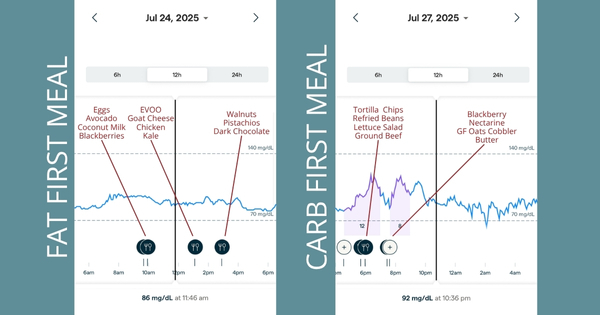Want Better Blood Sugar? Eat More Fat

The Skinny on Fat
If you’ve ever felt a burst of energy followed by a crash after a meal, you’ve likely experienced a glucose spike. This happens when the carbohydrates in your food quickly break down into sugar, flooding your bloodstream with glucose. In response, your pancreas releases insulin to shuttle that sugar into your cells. Ideally, your glucose should return to baseline—somewhere in the 80 mg/dL range for a glucose-tolerant individual—within about two hours after eating. But for many people, that’s not what happens.
Instead, glucose levels remain elevated, or swing rapidly, leading to symptoms like fatigue, irritability, sugar cravings, and energy dips. While these may seem mild or temporary, they’re often early indicators of deeper imbalance and an over-sensitivity to glucose.
Chronically mismanaged glucose doesn’t just affect your energy levels, it plays a key role in the development of metabolic diseases including obesity, hypertension, non-alcoholic fatty liver disease (NAFLD), and cardiovascular disease. It also contributes to low-grade inflammation and hormone imbalance, and underlies many chronic conditions ranging from PCOS to acne.
In previous articles we’ve explored that waiting for a diagnosis of mismanaged blood sugar common in mid-life and beyond puts you well behind in terms of optimal health outcomes.This is why blood sugar balance is one of our non-negotiables when it comes to building a foundation of health. We aren’t just looking at diabetes prevention. We’re talking about long-term energy, mood, focus, fertility, inflammation, disease prevention and even how well your brain and sensory organs age.
Reduce Glucose Spikes by Rethinking Your Plate
One of the biggest drivers of glucose imbalance is the type and amount of carbohydrates we eat, especially those stripped of fiber and nutrients, like white flour, sugary snacks, and sweetened beverages. Reducing simple carbs and focusing on whole, complex carbohydrates can help, but there’s more to the story.
An everyday strategy that works well in real life: pair your carbs with healthy fats, quality protein, and plenty of fiber. This combination slows digestion, promotes satiety, and helps your body regulate insulin more efficiently. You don’t have to eliminate carbs altogether, but the order you eat them, quantity, quality, and even when you eat them matter.
To make this point more tangible, I’m sharing a few real-time examples from my continuous glucose monitor (CGM). After one meal rich in fat, fiber, and protein: eggs, coconut milk, avocado, and a handful of blackberries (also high in fiber), my blood sugar barely budged. At lunch, I had a kale and chicken salad with goat cheese, walnuts, and a generous drizzle of olive oil, plus a touch of balsamic vinegar. Again, just a gentle rise in blood sugar that stayed well within my personal target range. Even a later snack of nuts and dark chocolate didn’t cause much disruption.

Now compare that to taco salad night. I started with a few blue corn chips (cooked in avocado oil), some refried beans, and salsa. Then came the salad with tomatoes, cheese, ground beef, and sour cream. My blood sugar response? A noticeable spike. And for experimentation, I didn’t give it time to recover before dessert, which was my wife’s famous homemade (and homegrown!) blackberry and nectarine cobbler with just a bit of coconut sugar and gluten-free oat topping, my glucose kept swinging. It didn’t just affect me in the moment; the pattern continued well into the night, disrupting what’s usually a steady nighttime blood sugar rhythm.
Why Fats are Essential
For years, fat has had a bad reputation, and based on what I see at the grocery store checkout, some of that has lingered. I grew up in the 80’s and we were told to avoid fat, cut calories, and eat “low-fat” everything. Cutting back a macronutrient like this gives little option but to increase another, most commonly carbohydrates and added sugars. What was missed is that while fats are calorie-dense, the right kinds of fat are essential, especially when it comes to blood sugar management, hormone health, brain function, and metabolic function.
Get this, your brain is nearly 60% fat, and every single cell in your body relies on fats to maintain the integrity of its membrane. Essential fatty acids, similar to essential amino acids (protein), must come from our diet as the body can’t manufacture them. And while carbs certainly are enjoyable, it’s worth noting that there are no essential carbohydrates and our bodies can produce glucose as needed. So if you have to cut out a macronutrient, better to err on the side of cutting carbohydrates and sugar than the essential macros we need.
Not All Fats Are Created Equal
All fat isn’t equal so the type of fat consumed makes all the difference. Wholesome sources of monounsaturated, polyunsaturated, and even saturated fats, like those found in coconut, olive, walnut, avocado, and grass-fed animal products, nourish your body in ways that highly processed industrial seed oils simply can’t.
Vegetable oils like soybean, corn, and canola are often highly refined and oxidized, and their fatty acid composition can contribute to inflammation and metabolic dysfunction. On the other hand, small fatty fish like sardines or wild-caught salmon provide clean omega-3s with fewer mercury concerns found in larger farmed or wild fish.
Each type of fat is processed differently by the body, depending on the molecular structure. This nuance influences how the fat is absorbed, metabolized, and ultimately used by your mitochondria to generate energy.
Avoid trans fats altogether—these chemically modified, shelf-stable fats are commonly found in packaged snacks and ultra-processed foods. They’re barely recognizable as food and have been linked to a wide range of chronic diseases.
One common concern about fat is its calorie content. Yes, fat provides 9 calories per gram, compared to 4 for protein or carbohydrates. But when healthy fats are consumed as part of a balanced, whole-food diet, they don’t cause weight gain on their own. The real trouble comes when fats are paired with refined sugars, flours, and ultra-processed foods like cupcakes, cookies, and brownies. That combination not only promotes weight gain, it gums up the inner workings of your metabolism.
Increasing Your Fat Intake
In fact, reducing refined carbohydrate intake while increasing healthy fats is one of the most effective strategies for stabilizing blood sugar, supporting a healthy weight, and encouraging metabolic flexibility. Here are some simple ways to add more nourishing fats to your meals:
Drizzle cold-pressed olive oil on salads, meats, or vegetables
Add coconut milk to smoothies or hot drinks for creaminess and flavor
Snack on nuts and seeds between meals for healthy fat and fiber
Eat the whole egg, not just the whites, for a nutrient-dense source of fat and protein
Cook with heat-stable fats like lard, tallow, coconut oil, or clarified butter
Don’t fear fat, it’s not the villain it’s been made out to be for most of us. In fact, it’s a delicious, powerful way to support blood sugar, fuel your brain, nourish your organs, and give your body the energy and stability it needs.
👋 PS - Interested in trying out a CGM for yourself? I put together a buying guide to help you sort through all the options available to find the best one. You can grab your free copy here.